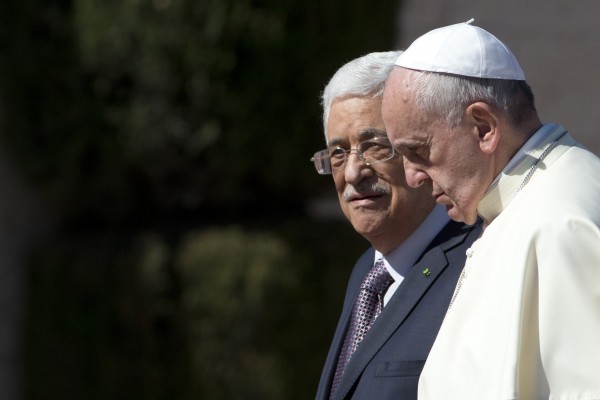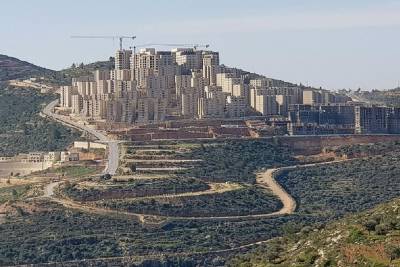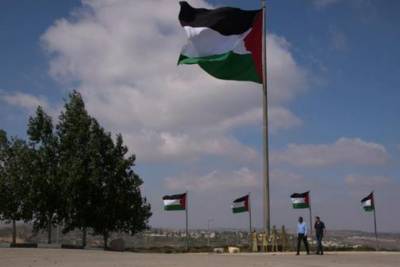The Palestinian landmark that Pope Francis missed

Pope Francis (right) meets Palestinian president Mahmoud Abbas in the West Bank town of Bethlehem May 25, 2014. Pope Francis made an impassioned plea for peace on a pilgrimage on Sunday to Bethlehem, the traditional birthplace of Jesus, urging an intensified effort to end the Israeli-Palestinian conflict.
Bloomberg News - Noah Feldman - It’s easy to sympathize with Pope Francis I, who stopped for silent prayer at the wall separating Bethlehem from Jerusalem: Sometimes it seems as if divine intervention is the only option left for Israelis and Palestinians who want peace. But there’s another spot the pope could have visited for a glimpse of optimism amid the deadlocked peace negotiations.
Just north of Ramallah, the planned Palestinian city of Rawabi is emerging from the side of a hill. Intended to house light industry, high-tech firms and as many as 30,000 residents, Rawabi is, strictly speaking, an impossibility under Israeli occupation and Palestinian Authority governance.
The idea behind Rawabi is deceptively simple. Israel has built plenty of master-planned cities — some, controversially, in the territories it conquered in 1967. Palestinian cities and towns, in contrast, have arisen organically from ancient agricultural towns and trading centers, or have been the impromptu byproduct of refugee camps melding into urban sprawl. Masri wanted to start from scratch and construct a new city designed for Palestinians.
His aim is to attract an aspiring middle class by building apartments designed for nuclear families, not extended clans. Many Palestinians live in freestanding houses that can be extended upwards and outwards to accommodate more family.
Rawabi offers something else that’s rare in the Arab world generally and Palestine in particular: Mortgage financing. Four different banks have offices in the sales center. This lowers the entry price point for prospective buyers and encourages bourgeois values.
So where’s the catch? Start with the regulatory nightmare of the West Bank. Most of Rawabi stands on what’s known as Area C, which is under Palestinian civil and security control. Building there requires land grants and permissions from the Palestinian Authority, which is known for being both broke and corrupt. Another part of the town is in Area B, which is under Palestinian civil authority but Israeli military authority — so all permissions must be duplicated.
And a crucial small part of Rawabi, including its access road, is in Area C, which is entirely controlled by Israel.
Beyond logistics there is ideology. Some Palestinians have criticized Rawabi as a copy of a settlement or, worse, an accommodation of the occupation. Israelis who favor the settlements, for their part, are challenged by Rawabi’s assertion of sovereignty. Masri says his Palestinian flags — he has a lot of them, including one that measures 9 by 20 meters — have been stolen by settlers from nearby Ateret.
Such practical challenges explain why Rawabi has sold only a few hundred units.
Why, then, do I find this undertaking so inspiring? It’s a question I couldn’t answer during my tour last week — until Pope Francis visited the grave of Theodor Herzl, the man Israelis call the founder of modern Zionism.
Rawabi has emotional resonance for me because it draws on the tradition of realist utopia. This same concept inspired the early Zionists to create facts on the ground in Palestine under the Ottoman Empire and the British Mandate. Those early settlers, unlike the ones who came along after 1967, had no state or army to fight their battles for them, and no reliable reason to expect they ever would. Yet, like Masri, they worked both with and against the existing authorities, always keeping their eyes on the prize of a better life.
No doubt he would also reject being compared with the pioneers who built the state against which his people struggle. His buyers come not from across the sea but from the neighboring cities and towns where their ancestors have lived for generations.
Yet Rawabi in its way is at least as visionary as its precedents. In the absence of a peace agreement, it is being built as though peace has already arrived. It is a realist utopia, a fact on the ground that contradicts the apparent impossibility of peace. Rawabi is not a solution, but it is a start.
To view original article, Click Here.



